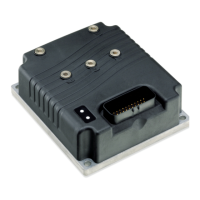Curtis 1222 Manual, os 15
2 9 J A N U A R Y 2 0 1 3
The Type C standards of EN 1175 define the hazards that must be ana-
lyzed. Four of the listed hazards are relevant to the Curtis 1222 Steering Con
-
troller: (1) crushing, due to unintended or uncontrolled movement; (2) loss of
stability, due to uncontrolled movement at speed, (3) failure of energy supply,
resulting in unintended steering or loss of steering; and (4) failure of control
system, resulting in unintended steering or loss of steering. The mitigating
Safety Function for these four hazards is “Prevention of Unintended Steering
or Loss of Steering.”
Curtis has analyzed each hazard and calculated its Mean Time To Dan
-
gerous Failure (MTTFd) and Diagnostic Coverage (DC), and designed them
against Common Cause Faults (CCF). The safety-related performance of the
Curtis 1222 is summarized as follows:
Safety Function
Designated
MTTFd DC
CCF
PL
Architecture Score
Prevention of unintended Category 3 ≥13 yrs ≥ 90% ≥ 65 d
steering or loss of steering
EN 1175 specifies that electronic steer control systems must use Designated
Architecture Category 3 or greater. This design employs input, logic, and output
circuits that are monitored and tested by independent circuits and software to
ensure a high level of safety performance.
Mean Time To Dangerous Failure (MTTFd) is related to the expected
reliability of the safety related parts used in the controller. Only failures that
can result in a dangerous situation are included in the calculation.
Diagnostic Coverage (DC) is a measure of the effectiveness of the control
system’s self-test and monitoring measures to detect failures and provide a safe
shutdown.
Common Cause Faults (CCF) are so named because some faults within
a controller can affect several systems. EN 13849 provides a checklist of design
techniques that should be followed to achieve sufficient mitigation of CCFs.
All circuits used by a safety function must be designed in such a way as to score
65 or better on the CCF score sheet as provided by EN 13849 table F.1.
Performance Level (PL) categorizes the quality or effectiveness of a safety
channel to reduce the potential risk caused by dangerous faults within the system
with “a” being the lowest and “e” being the highest achievable performance.
Contact Curtis technical support for more details.
APPENDIX B: EN 13849 COMPLIANCE
B-2

